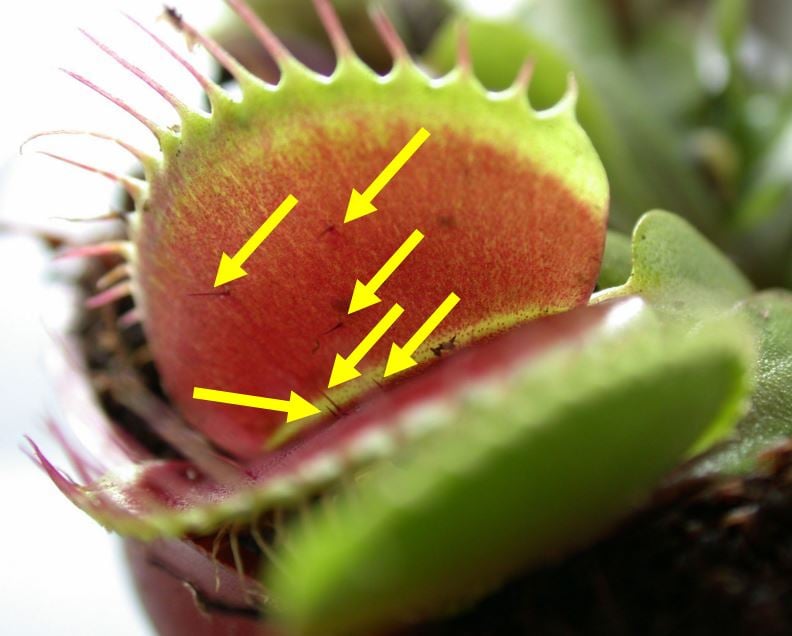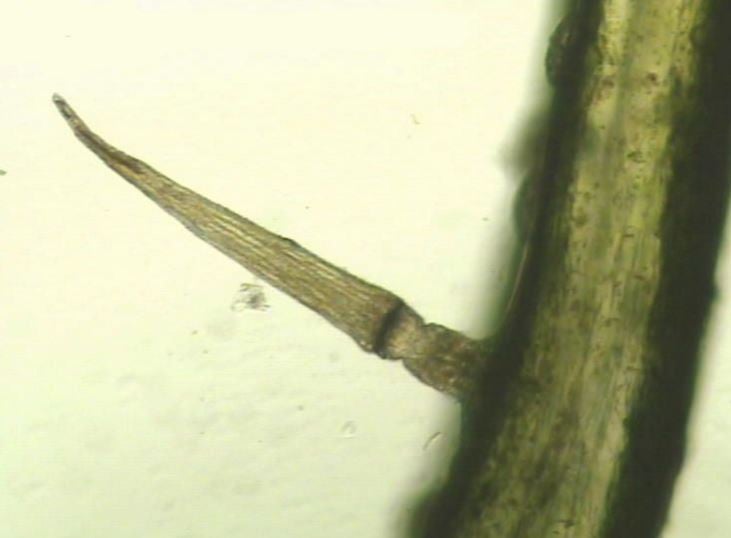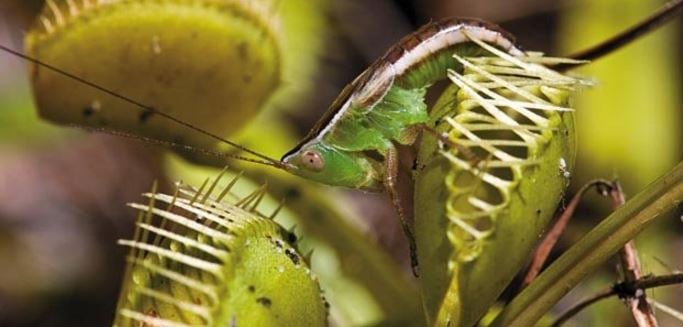The carnivorous Venus flytrap (Dionaea muscipula) can count, a skill it uses to avoid false alarms and conserve energy, a team of scientists from Germany and Australia has discovered. Its trap only closes after its sensitive hairs are touched twice, and usually starts to digest after the fifth touch.
By counting how many times they are touched, the tiny hair sensors inside the plant’s trap can distinguish prey from non-prey. An example of non-prey could be a droplet of water that falls into the trap.
The scientists wrote about their experiments and findings in the academic journal Current Biology.
 The Venus Flytrap has several trigger hairs on the inner surface of the trap, which trigger it be on ‘ready mode’ after one touch, and snap shut after the second. (Image: esf.edu)
The Venus Flytrap has several trigger hairs on the inner surface of the trap, which trigger it be on ‘ready mode’ after one touch, and snap shut after the second. (Image: esf.edu)
The Venus Flytrap, a carnivorous plant found in the subtropical wetlands of the East Coast of the United States, including North Carolina and South Carolina, might not scream out ‘Feed Me’, like the human-eating plant in the movie Little Shop of Horrors, but its sensitive hairs within each ‘trap’ count before the traps snaps shut.
The trap counts before deciding whether to snap shut
The tiny trigger hairs on the inner surfaces of the trap respond to the movements of a prospective meal. The plant’s eating behaviour is adjusted to the number of times the hairs are stimulated.
Professor Rainer Hedrich, who works at the University of Wurzburg’s Department of Botany, said:
“The carnivorous plant Dionaea muscipula, also known as Venus flytrap, can count how often it has been touched by an insect visiting its capture organ in order to trap and consume the animal prey.”
Prof. Hedrich and colleagues wanted to find out exactly what happens before the Venus flytrap closes its capture organ, and what occurs after its prey is trapped.
They fooled the plant into thinking prey had landed by applying artificial ‘touches’ to the trigger hairs.
 A close up of one of the Venus Flytrap’s trigger hairs. (Image: Wikipedia)
A close up of one of the Venus Flytrap’s trigger hairs. (Image: Wikipedia)
One touch triggers ‘ready mode’
The hairs were touched just once, and then twice, etc. They found that just one touch was enough to trigger the sensitive hairs to prime the trap, putting it in ‘ready’ mode – but it still stayed open.
After the second touch, the trap snapped shut, and the prey was captured and ready to consume.
After the fifth touch the plant started producing digestive enzymes and transporter molecules that helped absorb the nutrients.
How the plant responds depends on how many times it is touched, which the scientists found is linked to how big the meal is.
Number of touches linked to prey size
Prof Hedrich added:
“The number of action potentials informs the plant about the size and nutrient content of the struggling prey. This allows the Venus flytrap to balance the cost and benefit of hunting.”
The researchers are now trying to map the Venus flytrap’s genome. A creature’s genome consists of the complete set of genes or genetic material present in one of its cells.
By mapping its entire genetic code, they expect to learn more about how this amazing plant became a carnivore.
Little Shop of Horrors is a 1986 American rock musical horror comedy movie in which a nerdy florist shop worker raises a vicious plant that feeds on human blood. The musical was adapted from a 1960 B-movie where a man-eating plant is created by crossing a Venus flytrap with a butterwort.
About the Venus flytrap
The Venus flytrap gets its food through photosynthesis, just like other plants do. But it supplements its nutrients by trapping and digesting insects.
Its leaves secrete a sweet nectar that attracts insects in search of food. When the trigger hairs are touched in quick succession the leaf snaps shut ultra-fast – in less than one second.
 The Venus Flytrap is one of only two plants globally that actively trap animal prey. It secretes a sweet nectar that lures insects. (Image: smithsonianmag.com. Credit: Lynda Richardson)
The Venus Flytrap is one of only two plants globally that actively trap animal prey. It secretes a sweet nectar that lures insects. (Image: smithsonianmag.com. Credit: Lynda Richardson)
When the leaf is shut, an air-tight seal is formed to hold the digestive fluids and keep mold and bacteria out. Digestion is a slow process and can take from five the twelve days.
After digestion is completed, the leaf opens up again. Each leaf can only snap shut about ten to twelve times, after which it loses its ability to catch insects.
According to the State University of New York College of Environmental Science and Forestry, the Venus flytrap has been endangered in the wild due to over-collection by enthusiasts, pollution, and the destruction of its natural habitat (natural wetlands).
In the United States they are protected in the wild and must be cultivated through tissue culture or grown in greenhouses.
Citation: “The Venus Flytrap Dionaea muscipula Counts Prey-Induced Action Potentials to Induce Sodium Uptake,” Jennifer Böhm, Sönke Scherzer, Elzbieta Krol, Ines Kreuzer, Katharina von Meyer, Christian Lorey, Thomas D. Mueller, Lana Shabala, Isabel Monte, Roberto Solano, Khaled A.S. Al-Rasheid, Heinz Rennenberg, Sergey Shabala, Erwin Neher, Rainer Hedrich. Current Biology. 21 January, 2016. DOI: http://dx.doi.org/10.1016/j.cub.2015.11.057.
Video – Venus flytrap can count
In order to distinguish prey from non-prey like droplets of water, the Venus flytrap snaps shut only after its tiny hair sensors have been tripped.
